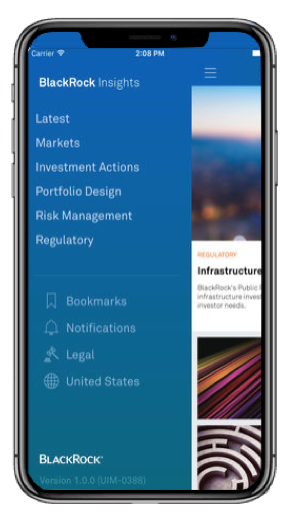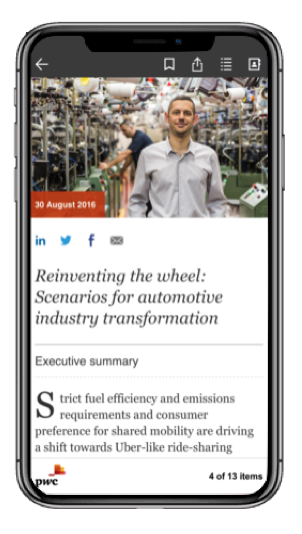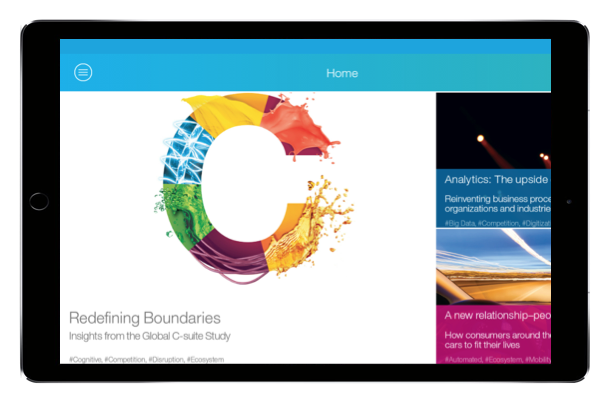Think on your feet: Get smart about mobile content
A vast array of digital content assets now forms the basis of most marketers’ activation plans. Traditional printers are no doubt mourning the loss of the glossy brochure, but those once-lucrative print budgets made way for digital design and development a long time ago. Videos, graphics and landing pages are now marketers’ weapons of choice.
Even the good old thought leadership PDF has undergone a digital makeover, with chapters converted to mini-reports and bar charts and statistics transformed into interactive data. And marketing departments are increasingly borrowing from content marketing to boost activation strategies and win more business.
Digital delivery has also revolutionised the way we consume content. We expect to be able to access it anytime and anywhere.
Most of the content we produce might be digital-ready, but with 30% of business-oriented-content consumers now accessing that content on the go, is it optimised for mobile? And how much does mobile really matter to our audience?
Upwardly mobile
What was once our smallest device is growing – in size and performance. Smartphones now have the processing power to navigate complex sites at speed, and the screens are large enough to give us a great, seamless experience.
These usability improvements mean that activities that were once inconceivable on smaller devices are now becoming second nature on smartphones. Creative content agency Alpha Grid has found that 74% of senior business decision-makers use their smartphones to watch work-related videos on the move, which puts these mobile devices ahead of laptops and tablets and second only to desktops (76%).
We need to turn our attention squarely to mobile – or lose those vital audiences. But what does that mean we have to do?
1. Make content easily accessible
As with all content creators, producers of thought leadership must take an audience-first approach. Not only is this best practice when it comes to deciding on themes and topics, it is now paramount when thinking about the activation.
Consider how, where and when your desired audience is most likely to access the content. Ensure that your content is easily accessible, and on as many platforms as possible.
If you do invest in a fully optimised mobile experience, then shout about it. Make sure your audience knows your content is available to read on the move. Clear signposting on both the desktop and mobile versions of your site will help with this.
2. Enhance the user journey – don’t limit it
With more budget and careful consideration now given to the activation strategy, leading brands are rightly starting to think about how readers are ‘funnelled’ through a content journey. When they plan campaigns, they borrow techniques from more traditional, consumer-focused marketing experiences to enhance the narrative.
Smarter brands are no longer simply publishing a report on a website and hoping for the best. Instead, they are atomising their content and exploiting mobile features such as touch and swipe actions to encourage audiences to participate in a more immersive experience.
Take your audience on a journey, through a range of content assets, and you’re far more likely to capture and hold their attention than by presenting them with a single downloadable report – however original the idea might be.
This multi-stage journey tactic is even more valuable on mobile. Content rendered on a small-screen device requires greater simplicity and clearer signposting to work well. Creating the illusion of a simple user journey, with bite-sized assets and a variety of pre-set routes to access the full content, will help when you have a rich collection of content available.
3. There’s an app for that
 The first iPad was released eight years ago, and many consumer-facing brands raced to be the first to build native apps (with most winning major cool points in the process).
The first iPad was released eight years ago, and many consumer-facing brands raced to be the first to build native apps (with most winning major cool points in the process).
B2B brands, however, have been slower to act, and more prudent. Used to taking a more measured approach to investment, most B2B brands waited for the dust to settle on the early adopters. They sought a clearer view of the benefits and disadvantages of apps with which to make a more informed decision.
 Now, we know that app features such as push notifications, in-app messaging and reminders increase content and commercial engagement both in the long and short term, and help producers to overcome the ‘out of sight, out of mind’ challenge.
Now, we know that app features such as push notifications, in-app messaging and reminders increase content and commercial engagement both in the long and short term, and help producers to overcome the ‘out of sight, out of mind’ challenge.
There are pros and cons to native apps and web apps, and deciding which type of app is right for your content delivery strategy will depend on your goals. If you’re looking for joined-up usage analytics and minimal investment, then a web app is probably a safer bet. But if you’re confident that your overall proposition is compelling enough to justify a native app experience, this approach will probably lead to more engagement from your audience.
IBM, PwC and Blackrock are examples of B2B brands leading the way in app-accessible content: all host their own branded content in a standalone app environment. These apps showcase the brands’ latest insights – along with large archives of historical articles – on purpose-built platforms that improve the user experience and reinforce the brand.
Is mobile-only thought leadership on the horizon?
Our always-on world is changing the way we live and work, and we’ve come to expect seamless and constant access to the content and insights we choose to make time for. So are we about to experience another shift in distribution – towards mobile-only content?
We don’t think so.
Mobile has, of course, had a huge effect on how we discover and read content, and audience preferences are undoubtedly changing, but smartphones are unlikely to be able to replace the sheer power, functionality and variety of the bigger screen any time soon.
Gleaning as much information as possible about our audiences has always been key to creating an effective content strategy. And as we learn more and more about where, when and how they choose to consume content, getting smarter about distribution has never been more crucial.
Click here to read our step-by-step guide to developing your thought leadership strategy






 Back
Back

 Book a meeting
Book a meeting
 Book a meeting
Book a meeting

